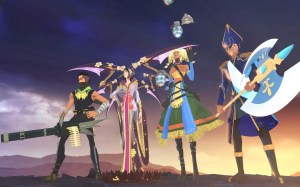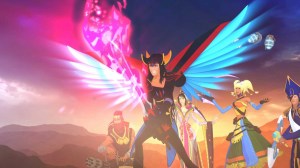 L.A.-based VFX studio Brewster Parsons recently delivered an animated 30-second commercial for gumi‘s mobile role-playing game “Brave Frontier.” Collaborating closely with both ad agency Ignited in Los Angeles and its client, gumi Inc., in Tokyo, the team at Brewster Parsons stretched creatively to design a Western anime look for the new project.
L.A.-based VFX studio Brewster Parsons recently delivered an animated 30-second commercial for gumi‘s mobile role-playing game “Brave Frontier.” Collaborating closely with both ad agency Ignited in Los Angeles and its client, gumi Inc., in Tokyo, the team at Brewster Parsons stretched creatively to design a Western anime look for the new project.
“We love character design and animation,” said Jason Cohon, executive producer at Brewster Parsons. “To date, a lot of our work has been firmly rooted in real-world based products, so this new spot gave us a chance to recalibrate our approach to the design and pay homage to some of the artists and genres we grew up with. When we kicked off the project, the whole team began referencing their favorite anime films from the past 20 years. The creativity and ideas were contagious, which was fun to see.”
“We were tasked with adapting the characters from the existing design of ‘Brave Frontier’ into a more elongated, sinewy, grittier version for western audiences,” said T.J. Burke, creative director and CG supervisor at Brewster Parsons. “The in-game designs are beautiful. We knew we had to adapt this artwork to a Western anime feel without losing the specifics that make each character unique. We teamed up with some fantastic concept artists early on who painted many iterations and takes on the characters that evolved through multiple conversations with the agency and clients.”
 Burke pointed out that the spot’s story was straightforward. The challenge was telling the story in an economical way. “We needed to get all of our ideas across in the allotted 20 seconds especially with almost no dialogue.”
Burke pointed out that the spot’s story was straightforward. The challenge was telling the story in an economical way. “We needed to get all of our ideas across in the allotted 20 seconds especially with almost no dialogue.”
The Brewster Parsons team leveraged references of 1980s and 1990s anime. “Our approach was to reverse engineer that look and rebuild it with our CG tools,” explained Burke. “It’s trickier than you might think because all of these tools are pretty much geared towards making mathematically perfect, photo-realistic images. We had to intentionally break the software to give everything more of a hand-assembled look.”
“We ended up throwing out our physically correct fire simulations in favor of a fractal/texture based fire, a much simpler effect, just because the simulation looked too real,” said Burke. “On the other hand, we used some heavy-handed glows and god-ray effects that would have never flown in a photo-real production, but looked right at home in our animation style.”





